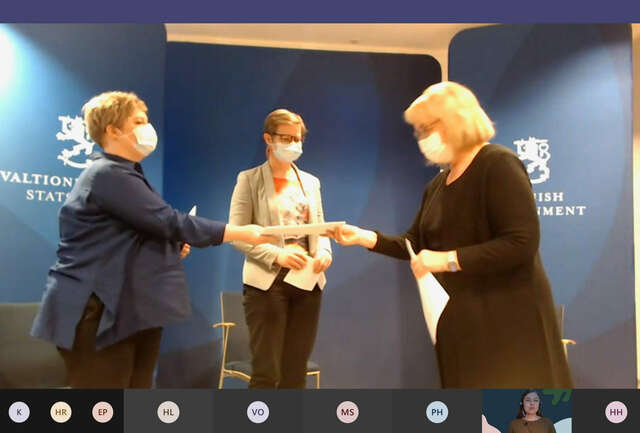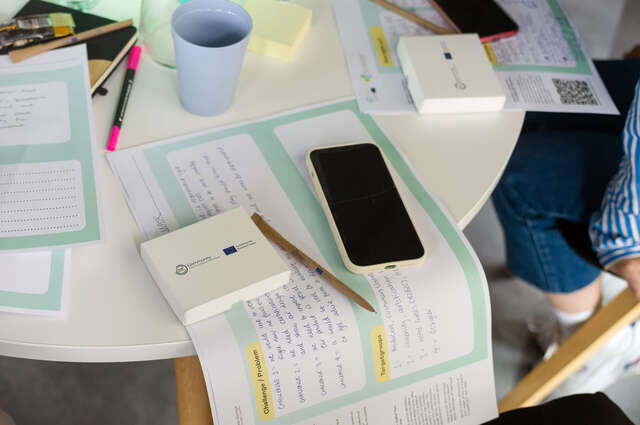Proposal for Finland’s new Architectural Policy Programme completed: Architecture must react to changes in society

The proposal for the new Architectural Policy Programme was submitted to the Minister of Science and Culture Annika Saarikko and Minister of the Environment and Climate Change Krista Mikkonen on 12 January.
The new Architectural Policy Programme draws guidelines to all who work or have an impact on the built environment. It defines the challenges to be solved and proposes actions to be taken to secure a sustainable future and the vitality of the architecture field.
During the Architectural Policy Programme work, which started in 2019, the working group has concentrated on how the Finnish architecture and built environment will be able to respond to the great societal challenges. Climate change, population ageing, urbanisation, new technologies and internationalisation demand new approaches and solutions.
The aims of the programme include enhancing the flexible use of buildings, creating criteria for the quality of housing construction, and increasing the appreciation of architecture and cultural heritage. The proposal stresses the significance of sustainable design and construction as a fundamental principle of architecture education as well as the role of architecture in interdisciplinary cooperation.
Climate change, population ageing, urbanisation, new technologies and internationalisation demand new approaches and solutions.
The programme proposal was submitted to the Minister of Science and Culture Annika Saarikko and Minister of the Environment and Climate Change Krista Mikkonen on 12 January.
“The aim is to strengthen cooperation between stakeholders that influence our built environment. This is needed to create a construction culture in Finland that boosts the economy in a sustainable way, offers solutions to international questions, and provides opportunities for every person to live in a good and comfortable environment,” Minister Saarikko says.
“Architecture connects broad outlines to individual, personal experiences. It is important that we understand the role of the built environment for the well-being of individuals and how they feel involved in society,” Saarikko adds.
"It is important that we understand the role of the built environment for the well-being of individuals and how they feel involved in society."
The programme proposal approaches the subject through five main themes: climate change and biodiversity, equality and involvement, economy and internationality, meaning and identity, and education and research.
“The working group has done a good job in recognising how good design, urban planning and construction can help find solutions to many societal challenges,” Minister Mikkonen says.
“Investments in the quality of zoning and construction take us towards a low-carbon built environment that will also cherish biodiversity. The proposal contains several measures that will lead to even more effective climate action in the built environment sector, such as developing methods to assess the impacts of zoning on emissions and the concept of a circular economy city block,” Mikkonen continues.
"The proposal contains several measures that will lead to even more effective climate action in the built environment sector"
Good design and planning of the built environment support viability, social equality and increasingly diverse ways of living, both in the growing towns and cities and in rural areas. The working group suggests ways to increase the participation of residents in the zoning and design processes. The proposals include joint facilities to support remote work and a set of criteria to be created for assessing the quality of housing construction. Awareness of the impacts of the built environment on health and well-being should be enhanced and the connections between these should be incorporated even more firmly into land-use planning and building design.
The programme proposal contains measures to support Finnish architecture export and make Finland increasingly attractive as a destination for architecture tourism. The architecture and design museum to be established in Finland would have a key role in promoting the culture of architectural exhibitions and events. The working group also proposes a prize to be awarded to sustainable construction of a high architectural standard.
The working group highlights the importance of securing the ability to respond to the changing needs through the education of architects and other professionals in the construction field and investing in the research of the built environment. The role of architectural and design education for children and youth must be strengthened for example by targeting state funding for the continuing education of teachers and pedagogues to architecture and design projects.
The architecture and design museum to be established in Finland would have a key role in promoting the culture of architectural exhibitions and events.
Finland’s first Architectural Policy Programme was published in 1998, more than 20 years ago. In May 2019, the Ministry of Education and Culture and the Ministry of the Environment appointed a working group to draw up a new Architectural Policy Programme. The working group consisted of a wide range of experts from different ministries, bureaus, municipalities, organisations and educational operators as well as the architecture profession. Archinfo Finland acted as the secretariat of the working group.
The proposal will now be sent out for comments and the feedback will be taken into account to finalise the programme. The proposal has been drawn up in Finnish and upon finalising, the programme will be translated into other languages.
#apoli2020


